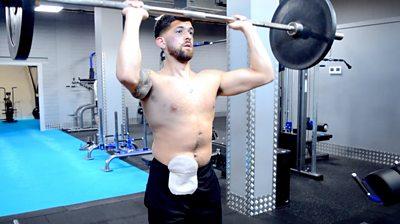‘A stoma bag gave me my life back – so I started taking part in endurance events’
When I was pregnant with my second child Natasha in 2005, I started getting awful stomach cramps and noticed blood when I went to the toilet. I was diagnosed with ulcerative colitis: an autoimmune disorder where your body attacks the lining of your colon.
After giving birth, things got worse and I lost two stone in just a fortnight. I got so thin that my body stopped producing milk; my mum said my legs looked like bits of thread hanging off my skirt.
I was put on steroids and other drugs to try to reduce the symptoms. However, I was convinced I could fix it “naturally” by changing my diet, so I cut out dairy and gluten and began trying things like wheatgrass shots. But it kept getting worse, to the point where I couldn’t sit on the floor to play with my children because it would make me need to immediately go to the toilet. On top of that, the steroids made me bloated and I gained more weight back than I had lost.
After four years of this, I realised I couldn’t control my symptoms through diet. In March 2009 I had an ileostomy formed, a procedure where my colon and large intestine were surgically removed and my small intestine was diverted. Instead of food and waste going through all my intestines and rectum, it now ends in a stoma bag on my abdomen.
The bag gave me my life back. I could leave the house without worrying and play with my children again without thinking about needing to be near a toilet.
After I had healed from the surgery I was finally able to look after my health again. I wanted to lose the weight I had put on with the steroids, so I signed up for a London to Paris charity ride, cycling 270 miles in 24 hours. I hired a personal trainer and did some hypnotherapy which helped me shift my mindset around exercise, allowing me not to fear exhaustion or discomfort. Just a year after surgery, I completed my first cycle race.
From there, I never looked back. Two years later, I rode a 300-mile Newcastle to London 24-hour endurance event, then decided to go for triathlons too. I started running and swimming – which many people worry about with a stoma – and worked up from sprint triathlons to full Ironman distances.

I’m driven by two things: I want to show my children how anything is possible if they put their mind to it and to show how much people with stomas can do.
My workout week
If I have a full Ironman coming up, I train six days a week for a total of 15 hours. During the week, I wake up early and either run or swim for an hour before work. A few evenings a week I jump on the turbo bike at home.
I save my long cycle sessions for the weekend because they take much longer. On a Saturday, I’ll do a “brick” session: four to five hours on the bike, then run for an hour straight away. This prepares you for the jelly legs you feel at the beginning of the running section of a triathlon after hours of cycling. On Sundays, I rest.
What I eat in a day
Breakfast
Before going out to train I have either a banana or porridge and afterwards, I’ll have a protein shake to refuel. Whilst racing, I eat about a third more than the average triathlete because my body can’t absorb nutrition as well, and I use electrolytes as I have to be careful not to get dehydrated.
Lunch
I often have poached eggs on a bagel for lunch.
Dinner
I cook a lot of traditional English food, so it’s often meat and vegetables, but I do also have pasta – particularly the night before a race. It’s all about having good quality, non-processed food.
Snacks
Biscuits and chocolate are my downfall, but I don’t worry about having a sweet treat when I’m training a lot.
Lifestyle asides
I’m not a regular drinker but might have the odd celebratory glass. With a busy work life, family and dog, I get about six hours of sleep a night.
If you’ve been affected by this condition, help and support is available from Ileostomy & Internal Pouch Association
As told to Helen Chandler-Wilde



